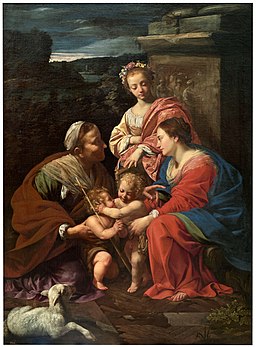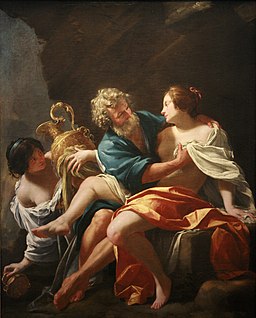
Self-Portrait, 1627
Born on January 9, 1590 in Paris, Simon Vouet was the giant of his era and is credited with introducing Baroque art to France. Coming from a family of painters, his precocious talents lead him to travel at quite a young age and in his early twenties he stopped in Italy and lived there for 13 years, longer than any other European artist at that time. His extensive travels within Italy allowed him to absorb all the major painters and styles with keen fascination, clearly inspired by the rich history of art that was lacking back in his native France. During this period he also became a "principe" at the Accademia di San Luca in Rome, and probably the first non-Italian artist to teach there. Vouet's talent and sharp business savvy led him to a very successful career and a pioneer of the Baroque outside of Italy.
Above is his self-portrait, one of my very favourites for its spontaneity and freshness with skilled brushwork. Painted in his late thirties shortly after he was married, Vouet displays a confidence and verve of an artist at the peak of his powers.

Saint Cecilia, ca.1626
The patron saint of music that Paul Simon would lament to centuries later, Vouet gives her a grace by using drapery that flows around her loosely resembling a treble clef. Look at the incredible brushwork of her pink sleeves, with greyish-purple midtones and warm reflected tones under her forearm. It harmonizes perfectly with the blue underneath. The drapery that envelops her has an ornate texture that contrasts with the soft white fleece-like material inside. Her gaze is directed upwards in divine inspiration, yet she evokes a sensuality that is both Classical and lifelike.

Crucifixion, 1622
Vouet chooses an unusual low vantage point to heighten the drama of this familiar scene and to emphasize the heavens above. S-curves seem to dominate the figure arrangement of Vouet's work, as evident in the figure wrapping her hands around the cross and in the two figures at left, whose heads lead upward to Christ yet the man's arms also point back to the woman at the cross. Vouet also favors dramatic backgrounds, not merely the blackness of Caravaggio and other tenebrists, but using a dominant color— dark, smoky orange in this case— to add depth and mystery to the drama. This orange motif is repeated in the drapery of the women at right, where it veers towards yellow, until it suddenly becomes bright red-orange in the man at left. Note the way Christ's loincloth blows behind him in the wind. The entire middle section of the painting is empty, which intensifies the crisis. Above them cherubs weep and cover their eyes in disbelief.

The Holy Family with Sts Elizabeth, John the Baptist and Catherine, 1626
Here we can see the influences of the Renaissance from Da Vinci to Raphael, yet curiously Vouet portrays them in a light without deep shadows, choosing instead to highlight his natural ability with drapery. Note the triangular arrangement of the women's heads. Vouet may have been attempting the impossible in that he creates a typical religious theme with natural body language and facial expressions, especially in the way Saint Elizabeth looks toward Mary and points with her hand at her. Saint Catherine stands above them, a young girl with noble intelligence, indicating her loyalty to Christ and alluding to his crucifixion with a broken wheel. A complex painting that could have been painted a million different ways, Vouet chooses the most harmonious, most likely to appease Casiano dal Pozzo, the Italian scholar and collector who commissioned it.

Saint Jerome and the Angel, ca. 1625
A stunning achievement, this depiction of Saint Jerome is closer to the tenebrism of Caravaggio yet has Vouet's natural body language, the figures appearing midway in discussion. Note the angel's spectacular drapery and color. The dark, warm background hues add to the mystery of this scene. Saint Jerome is painted in flawless skin tones and rich character in his face, wise and strong but not gaunt or emaciated as some have depicted him. Note the warm yellow highlights in the wrinkles of his forehead and on his nose. This is a painting to see in person.
Below are a couple of Vouet's studies:

Female study

Portrait of Giulio Strozza, 1627

Father Time Overcome by Love, Hope and Beauty, 1627
Click here for Prado Museum's close up view
A well-recognized work, this is Vouet unfettered and purely enjoying himself, the result being one of his best. Father time, represented as Saturn here, falls to the ground with his hourglass held sideways and scythe next to his feet. Hope, to the left brandishes a hook or anchor while Beauty (a possible portrait of Vouet's wife Virginia Vezzo) grabs his hair and playfully threatens with a spear. Father time is apparently not too pleased with getting his ass kicked by two women either, which adds more to the humour. Look carefully at the way Vouet has painted the cherubs, especially the one grasping the wings of Father Time—he is blind. Meanwhile, the cherub on the ground appears to be peering up the skirt of Beauty. The background detail is breathtaking, changing from left to right as a tree and rocky landscape to distant blue skies. Note again the drapery fluttering in the wind. With a simple triangular composition Vouet takes a silly theme and makes pure magic.

Loth and his daughters, 1633
A highly sensual piece for its time, Vouet was already foreshadowing the eroticism of the Rococo. Incredible skin tones here. Look at the warm pinks of the legs on the daughter to the right, with green-grays in the shadows. For what seems to be the first time, Vouet restrains his effortless penchant for drapery and focuses on the facial expressions and body language of the three. Despite the biblical story and the frank implications of incest, here Vouet imbibes this theme with pure sensuality in way that is somehow tasteful and acceptable, an incredibly difficult thing to do. Compare with this even more frank yet unsettling depiction by Goltzius.

St Catherine, 1615
This portrait, very atypical of Vouet and quite formal, even stiff-looking, has an unearthly quality that is hard to define. More iconic than portrait, the only defining characteristic of Vouet is the brilliant drapery on her arm and ornate details of her uniform, as well as the hands. Note the brushwork and rusty midtones and shimmering highlights on that arm.

Portrait of a gentleman with his dog, ca.1621
Click here for zoomable version
A fine portrait that brings to mind the Flemish and Van Dyck, here Vouet clearly outdoes himself with costume and ornate detail that would challenge the patience of virtually any artist. Vouet clearly trumpets the reputation of this unknown French nobleman who appears to be a knight. Having a portrait painted of someone by the likes of Simon Vouet would have been an illustrious status symbol of the day, and here he delivers holding nothing back.

Judith with head of Holofernes, 1650's
More portrait than biblical story, Judith poses for us as a heroine and not a sadistic misandrynist as tenebrists such as Artemisia have depicted. Holofernes' head is securely underneath her arm and in shadow, and she seems to be giving him a postmortem haircut to boot. Again, the drapery is rich and sensuous. Vouet is commenting on female power being more about control than revenge, without bloodshed or violence but with subtlety.

La Présentation au Temple, 1641
Note the dominant triangle of all the figures on the left, along with their shadow on the steps. Note the space above them is an empty triangle in the opposite direction, a brilliant stroke of genius. This is how Sebastiano Conca would have painted his figures if he had Vouet's knowledge of anatomy and facial expression. Here Vouet holds back on the drapery to tell the story, and the background architecture does precisely this.

Venus and Adonis, 1642
Sensual and romantic, this is a less Classical take on mythology with Adonis appearing to be a younger version of Vouet himself. The skin of Venus is cool and soft, with subtle gray shadows. Set against a verdant ordinary background, it is not the peak of Vouet's potential but seems to foreshadow the Rococo and its excesses.

Saturn, Conquered by Amor, Venus and Hope, 1646
Compare this Baroque drama with Father Time Overcome by Love, Hope and Beauty above and how versatile Vouet becomes. Saturn is now a victim being attacked by two virtues and a goddess which appear more sinister than genuine. This time the hourglass is missing, and despite his scythe and anchor Saturn is a poor old man who cannot defend himself. Now eternal, these three reign over the affairs of humanity and signal the arrival of narcissism and vanity.

Lucretia And Tarquin, 1600's
Another piece with dark symbolic undertones, Vouet takes this ancient Roman story painted by countless artists and gives it his unique musical figure arrangement. A story of downfall and excess, Vouet unwittingly foreshadows the end of the Baroque and possibly Rococo itself. Note the minimal detail in the drapery compared to previous works, leaving instead the canopy above them in rich folds of detail and texture. However, Vouet still utilizes the prominent S curve in these two figures. Vouet not only impacted art in France, but left a mark on the artists who would follow in his footsteps, defying Time itself and truly becoming immortal himself.
Comments
Post a Comment